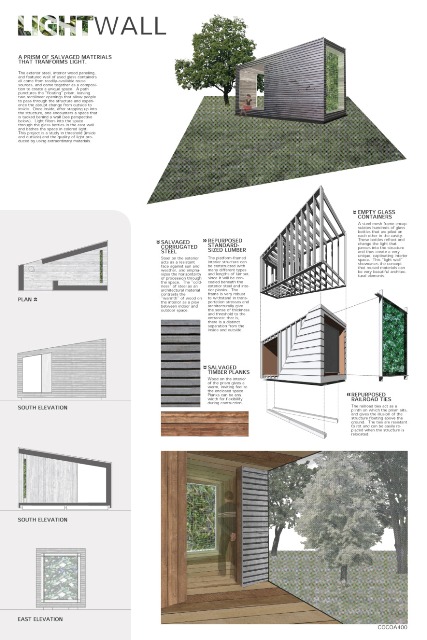
Online bids are now being accepted on the “LightWall Pavilion,” the Grand Prize winner of the inaugural ReSpace Design Competition made entirely of salvaged materials. The Competition was sponsored by Habitat for Humanity of Wake County, the American Institute of Architects’ Triangle section, and Architecture For Humanity’s Raleigh chapter. All proceeds will benefit Habitat Wake.
On Saturday, June 1, from 9-11 a.m., AuctionFirst, the real estate bidding agency for the “LightWall,” will host a Preview Tour in the parking lot of Habitat Wake County’s ReStore’s parking lot at 2420 N. Raleigh Boulevard, Raleigh, NC 27604, where the pavilion is stored.
Scott Hefner and Abe Drechsler, two NCSU students studying Environmental Design in Architecture, designed the pavilion, which measures 18.5 feet long, 11.5 feet wide, and 11 feet tall, and is destined for a variety of uses – from a gazebo-like structure in the landscape, to an artist’s or writer’s studio, a playhouse, a meditation retreat, etc.
Materials, donated or salvaged from around Wake County, include:
- Framing lumber salvaged by Habitat Wake’s DeConstruction program
- Interior Maple gym flooring from Chapel Hill High School
- Diagonal floor sheathing for exterior siding from the DeConstruction program, and manufactured siding donated to the Habitat ReStore in Raleigh
- Weather barrier and roofing donated to the Raleigh ReStore
- Old pallet racking from the Raleigh ReStore and reused glass bottles from various bars and restaurants in downtown Raleigh. The bottles create the “light wall” that filters sunlight and bathes the interior in colored light.

Joel Lubell, a builder and volunteer at Habitat, conceived of and organized the ReSpace Competition “to raise awareness of reuse materials while showcasing creative and successful small space designs inspired by their use,” according to his website www.respace.org. Lubell and a small army of Habitat volunteers built the structure during a 48-hour construction blitz.
Matthew Szymanski, chairman of AIA Triangle’s Young Architects Forum committee, added his feelings about the competition: “We wanted to make ReSpace more than a contest. We wanted it to be an experience that would change people, and tying it to reuse has done that.”
Szymanski firmly believes that once designers and builders have worked with salvaged materials “they’ll be more likely to do it again and again and again.”
Joel Lubell noted another value: “The materials all have a story. They all come from somewhere. You get an idea that something came from your local area and it’s got history to it.”
The contest’s jury included North Carolina architect Ellen Weinstein, AIA, who admired the LightWall’s minimalism. “I just found it to be a simple and elegant structure in the landscape,” she said.
According to the young designers, “simple” was a necessity. Both students were extremely busy as the deadline for submissions neared, so they designed something quickly during a two-hour brainstorming session, using markers and trace paper.
“We reasoned that we didn’t have enough time before the deadline to add too many layers of complexity,” Hefner said. “Little did we know that the LightWall’s inherent simplicity would be one of its strongest traits.” The entire structure fits on a lowboy trailer for shipping anywhere in the country.
“This will be a fascinating auction,” said auctioneer Sarah Sonke. “The success will depend upon bidders’ imaginations – what wonderful purposes they see for the pavilion.”
Bidding will end at 8 p.m. on June 11. The website (http://habitatonlineauction.com) includes information on how to bid and videos of the competition and “construction blitz.”
For more information on this and future ReSpace Design Competitions, go to www.respace.org.

 The recent North Carolina drought and subsequent water shortage in the Raleigh area is still fresh on our minds as we head into a new summer season, already in a rain deficit. Last year we installed a
The recent North Carolina drought and subsequent water shortage in the Raleigh area is still fresh on our minds as we head into a new summer season, already in a rain deficit. Last year we installed a 









